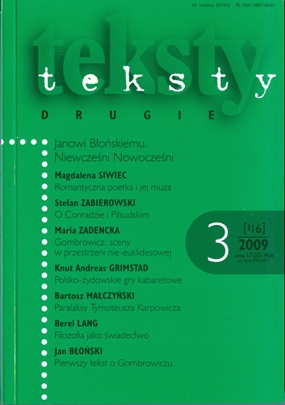Czystość, brud i chaos rewolucji. O dwóch częściach "Przedwiośnia"
Purity, Dirt, and Revolutionary Chaos: Two Parts of Żeromski’s "Przedwiośnie"
Author(s): Łukasz PawłowskiSubject(s): Literary Texts
Published by: Instytut Badań Literackich Polskiej Akademii Nauk
Keywords: Stefan Żeromski; "Przedwiośnie"; Polish Literature (20.c); Revolution
Summary/Abstract: In his analysis of two parts (respectively titled Szklane domy and Nawłoć) of Stefan Żeromski’s classical novel Przedwiośnie [1924/1925], inspired by the anthropology of (im)purity, works by Mary Douglas and Julia Kristeva, the author emphasises what is, as he believes, a major process of constructing the social reality of the Second Polish Republic [1918–1939], consisting in separating and discerning an emerging orderliness from the menacing Other – the revolutionary Russia. Hence, the first section of this interpretative text is focused on establishing a symbolic borderline between the new state and the Empire possessed by destruction. In the second section, attention is drawn to this border being non-hermetical: the author seeks for traces of revolutionary chaos within cultural frameworks of Polish reality, even if in its Arcadian vision shown by Żeromski in Nawłoć. Research questions on consequences of the discussed (de)symbolisation processes for an image of the Second Republic’s social world, taking shape in Przedwiośnie as well as in other literary texts of the period 1918–1925, appear in conclusion.
Journal: Teksty Drugie
- Issue Year: 2009
- Issue No: 3
- Page Range: 176-188
- Page Count: 13
- Language: Polish

